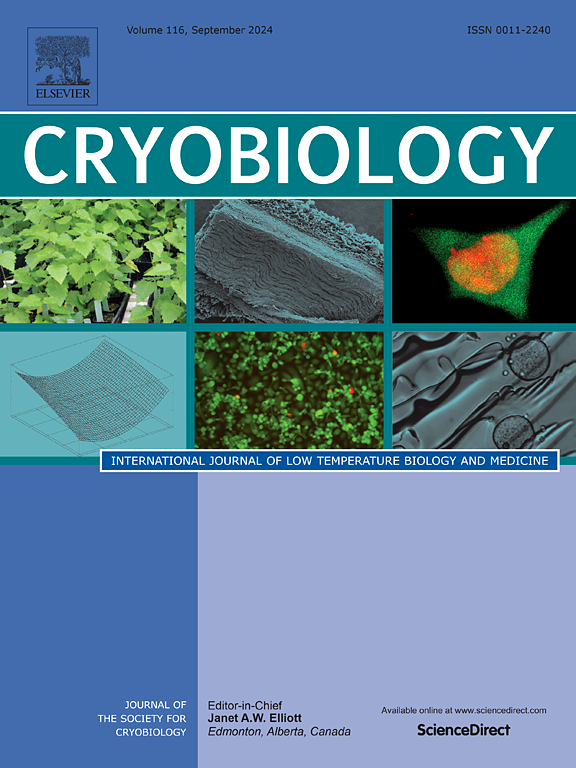Retrospective analysis of sperm metrics in fresh ejaculates of collared peccaries presenting contrasting semen freezability
IF 2.1
3区 生物学
Q2 BIOLOGY
引用次数: 0
Abstract
Based on a retrospective study of sperm parameters in raw ejaculates of collared peccaries classified as good and poor freezers, this study aimed to identify whether these animals present different sperm characteristics that allow predicting their contrasting freezability. For this purpose, ejaculates were obtained from twenty-six animals, in which an aliquot of fresh semen was immediately evaluated, while another aliquot was diluted in Tris-yolk-glycerol diluent and cryopreserved. Fresh and frozen/thawed samples were evaluated for sperm motility kinetic parameters, membrane integrity, mitochondrial activity, membrane functionality, sperm morphology and sperm binding capacity. Based on post-thawing sperm metrics, the animals were classified as good and poor freezers. Following this classification, a retrospective study of fresh ejaculates was performed, in which a reclassification of the samples was performed according to the groups obtained after thawing. For the thawed groups, analysis of variance was performed using SAS software and the Tukey mean test to detect the significant differences between the groups. For fresh samples, the Mann Whitney test was used to verify the difference between the groups regarding the kinetic motility parameters (MT, fast, medium, slow and static cells), mitochondrial activity, pH and sperm concentration. For the other fresh parameters, the Unpaired t-test was used, using the GraphPad Prism® software version 9.3 for Windows (GraphPad Software Inc., San Diego, CA, USA). The highest (P < 0.05) mean values of post-thawing sperm motility were verified for good freezers (42.8 ± 2.8 %), to the detriment of bad freezers (23.8 ± 2.7 %). Good freezers also showed the highest (P < 0.05) mean values of progressive sperm motility (25.8 ± 2.5 %), lateral head amplitude (6.1 ± 0.1 μm) and proportion of fast sperm (31.1 ± 2.6 %), while poor freezers showed the highest proportion (P < 0.05) of static sperm (72.8 ± 3.4 %). Regarding raw semen, all ejaculates had a milky appearance and whitish coloration. There was no statistical difference between the groups regarding the kinetic motility patterns (P > 0.05). Poor freezers provided the lowest percentage (P < 0.05) of sperm with intact membranes (78.8 ± 1.7 %) and mitochondrial activity (79.3 ± 1.8 %), compared to good freezers (87.0 ± 1.9 %; 87.3 ± 1.9 %), with no differences regarding the other parameters. In conclusion, sperm plasma membrane integrity and mitochondrial activity in raw semen appear to be useful for predicting the freezability of semen from collared peccaries classified as good and poor freezers.
有领鱼类新鲜射精中精子指标的回顾性分析,呈现出对比的精液冷冻性
基于一项回顾性研究,将有项圈的鱼的原始射精中的精子参数划分为优质和劣质冷冻库,本研究旨在确定这些动物是否表现出不同的精子特征,从而可以预测它们的冷冻性。为此,从26只动物身上获得了射精,其中一份新鲜精液立即被评估,另一份在三蛋黄甘油稀释液中稀释并冷冻保存。对新鲜和冷冻/解冻样品进行精子运动动力学参数、膜完整性、线粒体活性、膜功能、精子形态和精子结合能力的评估。根据精子解冻后的指标,这些动物被分为冷冻效果好的和冷冻效果差的两类。在此分类之后,对新鲜射精进行了回顾性研究,其中根据解冻后获得的组对样品进行了重新分类。解冻组采用SAS软件进行方差分析,采用Tukey均数检验,检验组间差异是否显著。对于新鲜样品,使用Mann Whitney测试来验证各组之间在动力学参数(MT,快速,中等,慢速和静态细胞),线粒体活性,pH和精子浓度方面的差异。对于其他新鲜参数,使用GraphPad Prism®软件版本9.3 For Windows (GraphPad software Inc., San Diego, CA, USA),使用Unpaired t检验。解冻后精子活力的平均值最高(P < 0.05),冷冻条件好的精子活力平均值最高(42.8±2.8%),冷冻条件差的精子活力平均值最高(23.8±2.7%)。良好冷冻室的精子动态平均值(25.8±2.5%)、侧头振幅(6.1±0.1 μm)和快速精子比例(31.1±2.6%)最高(P < 0.05),而较差冷冻室的静态精子比例(72.8±3.4%)最高(P < 0.05)。对于生精液,所有的射精都呈乳白色。两组间的运动模式差异无统计学意义(P > 0.05)。与良好的冷冻柜(87.0±1.9%;87.3±1.9%)相比,劣质冷冻柜提供的精子完整膜(78.8±1.7%)和线粒体活性(79.3±1.8%)的百分比最低(P < 0.05),其他参数无差异。综上所述,生精液中的精子质膜完整性和线粒体活性似乎有助于预测有圈鱼精液的冷冻性,这些精液被分类为优质和劣质冷冻库。
本文章由计算机程序翻译,如有差异,请以英文原文为准。
求助全文
约1分钟内获得全文
求助全文
来源期刊

Cryobiology
生物-生理学
CiteScore
5.40
自引率
7.40%
发文量
71
审稿时长
56 days
期刊介绍:
Cryobiology: International Journal of Low Temperature Biology and Medicine publishes research articles on all aspects of low temperature biology and medicine.
Research Areas include:
• Cryoprotective additives and their pharmacological actions
• Cryosurgery
• Freeze-drying
• Freezing
• Frost hardiness in plants
• Hibernation
• Hypothermia
• Medical applications of reduced temperature
• Perfusion of organs
• All pertinent methodologies
Cryobiology is the official journal of the Society for Cryobiology.
 求助内容:
求助内容: 应助结果提醒方式:
应助结果提醒方式:


